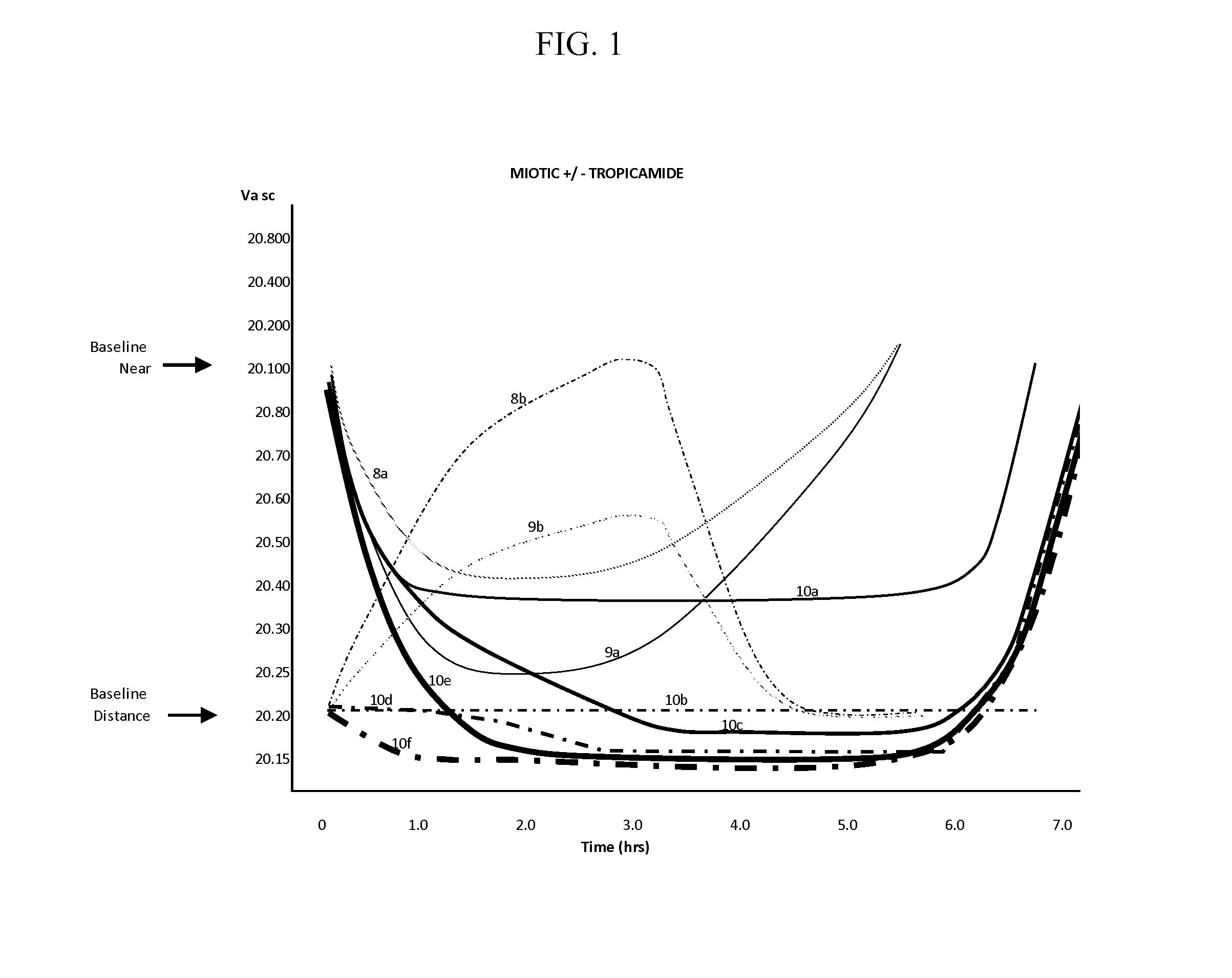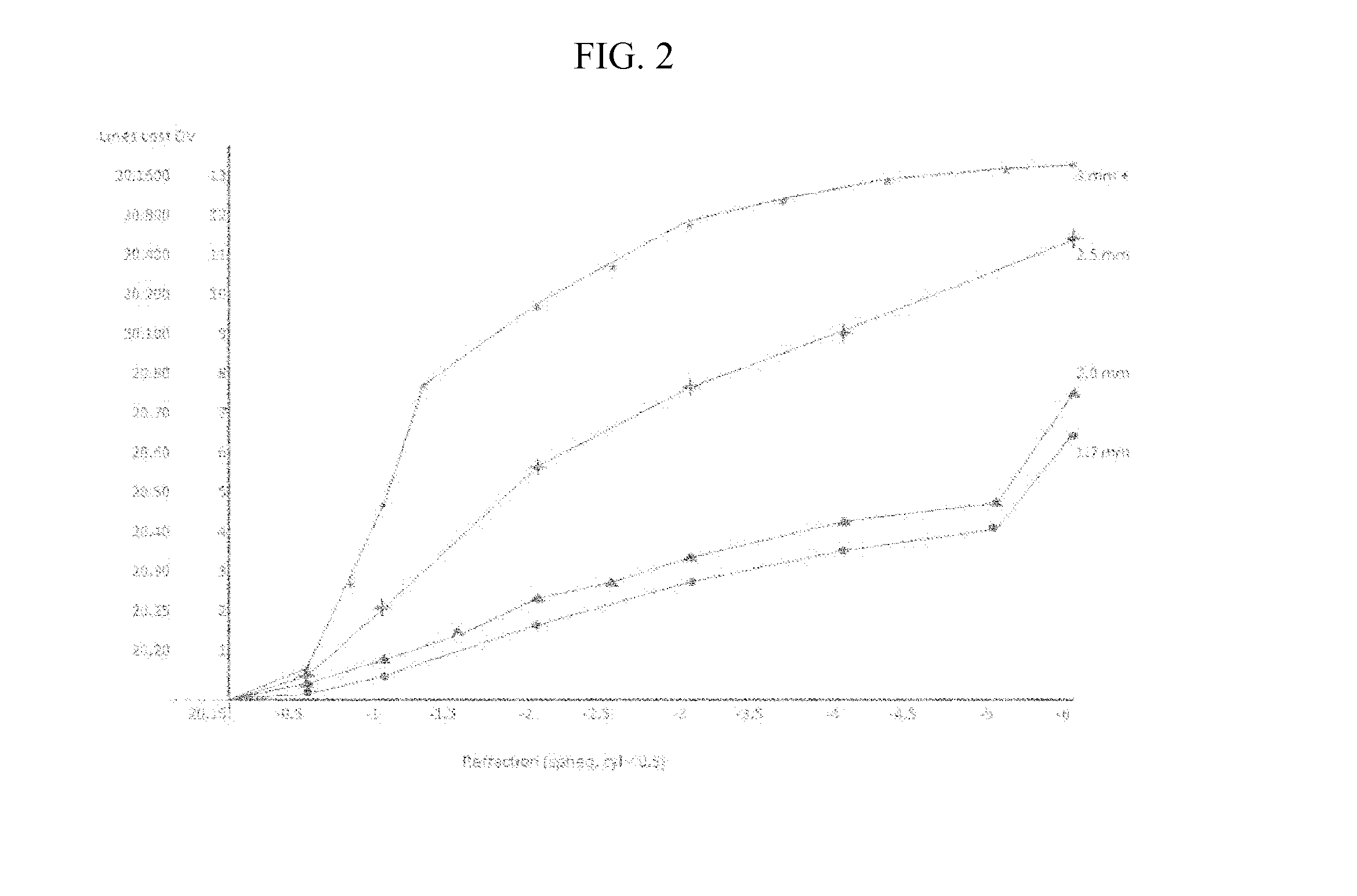Compositions and Methods for the Treatment of Presbyopia
- Summary
- Abstract
- Description
- Claims
- Application Information
AI Technical Summary
Benefits of technology
Problems solved by technology
Method used
Image
Examples
example 1
Effect of Aceclidine on Vision of Subjects Aged 47 to 67 Years
[0160]Table 1 demonstrates the effect on the near focus ability of presbyopic subjects before and after ophthalmological administration of a composition containing aceclidine. Each composition included aceclidine in the concentrations indicated and 5.5% w / v HPβCD, 0.75% w / v CMC, 0.25% w / v NaCl and 0.01% w / v BAK. Additionally compositions administered to subjects 4 and 5 included 0.125% w / v tropicamide. As aceclidine is an enantiomer, the clinical effectiveness may vary with different ratios. For the present studies a nearly exact 50:50 ratio of stereoisomers was measured as best determined by polarimetry.
TABLE 1Effects of aceclidine on vision of presbyopic patients.Vision BaselinePost Gtt 15″AceclidineR PreL PreR PreL PreR PostL PostR PostL PostEffectDate#Age%DistDistNearNearDistDistNearNear(h)Aug. 21, 20131671.520.2020.3020.6020.6020.2020.2020.1520.159.00Aug. 22, 20132521.520.3020.3020.5020.5020.2520.2520.2520.208.00Aug....
example 2
Effect of Concentration of Concentration of Aceclidine and Tropicamide
[0162]
TABLE 2Effect of concentration of concentration of aceclidine and tropicamide.#1#2#3#4#5 (OD)#5 (OS)#6#7Brimonidine0.03%0.03%0.03%0.03%0.03%0.03%0.03%Poloxamer 407 5.5%HPBCD 5.5% 5.5% 5.5% 5.5% 5.5% 5.5% 5.5%Aceclidine 1.5% 1.5%0.75% 1.1% 1.1% 1.1% 1.1% 1.1%Tropicamide0.014% 0.021% 0.028% 0.042% 0.062% NaCl0.25%0.25%0.25%0.25%0.25%0.25%0.25%0.25%CMC0.75%0.75%0.75%0.75%0.75%0.75%0.75%0.75%BAK 0.1% 0.1% 0.1% 0.1% 0.1% 0.1% 0.1% 0.1%Redness (15 m)3+ 1 0.50.50000Redness (30 m)1.50.50.250.250000Brow Ache2+ 2+ 20.50.50.00.00.0(60 m)Stinging (10 m)2 2 0.500000BD-OD20.2020.2020.2020.2020.2020.2020.2020.20BD-OS20.2520.2520.2520.2520.2520.2520.2520.25BN-OD8 pt 8 pt 8 pt 8 pt 8 pt 8 pt 8 pt 8 pt BN-OS7 pt 7 pt 7 pt 7 pt 7 pt 7 pt 7 pt 7 pt BP-photopic3 mm3 mm3 mm3 mm3 mm3 mm3 mm3 mmBP-mesopic5 mm5 mm5 mm5 mm5 mm5 mm5 mm5 mmMiosis start (m)15 15 151515151515Miosis (OU)1.63 mm 1.63 mm 2.0-2.5 mm 1.63 mm 1.63 mm...
example 3
Effect of Concentration of Aceclidine, Brimonidine, Guanfacine, Fadolmidine, Tropicamide and Additives
[0169]
TABLE 3Effect of concentration of aceclidine, brimonidine, guanfacine,fadolmidine, tropicamide and additives.AB2TAB4TAB6TAB11TAB12TPROPH13Aceclidine1.551.551.551.551.851.55Brimonidine0.0370.0370.0370.037Fadolmidine0.037Guanfacine0.037HPBCD5.55.55.55.55.55Tropicamide0.0430.0430.0430.0430.0420.043CMC*0.0750.0750.0750.0750.0750.075NaCl0.0250.0250.0250.0250.0250.025BAK0.010.010.010.010.010.01Glycerin0.10.10.1Poloxamer 1880.10.05Polyoxyl 40 stearate0.05pH6.57.57.57.57.07.5nasal congestion000000stinging initial0.7501.53.501.5stinging, 3 min0.500wash out00redness initial001D / C11redness 15 min000D / C00whitening000D / C1.51.5pain000D / C00vision near20.3020.1520.15D / C20.1520.15vision distance20.2020.2020.20D / C20.2020.20onset (min)201216D / C1216duration (hrs)5.57.57.5D / C7.57.5colorclearyellowyellowyellowyellowyellowOVERALL2.53.93.8043.9*1% = 2,500 cps
[0170]All percentages are w / v. Scores for ...
PUM
| Property | Measurement | Unit |
|---|---|---|
| Fraction | aaaaa | aaaaa |
| Fraction | aaaaa | aaaaa |
| Concentration | aaaaa | aaaaa |
Abstract
Description
Claims
Application Information
 Login to View More
Login to View More - R&D
- Intellectual Property
- Life Sciences
- Materials
- Tech Scout
- Unparalleled Data Quality
- Higher Quality Content
- 60% Fewer Hallucinations
Browse by: Latest US Patents, China's latest patents, Technical Efficacy Thesaurus, Application Domain, Technology Topic, Popular Technical Reports.
© 2025 PatSnap. All rights reserved.Legal|Privacy policy|Modern Slavery Act Transparency Statement|Sitemap|About US| Contact US: help@patsnap.com


